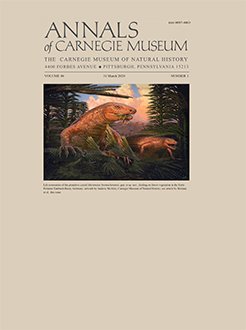The anatomy of the petrosal and associated middle ear structures are described and illustrated for the brown rat, Rattus norvegicus (Berkenhout, 1769). Although the middle ear in this iconic mammal has been treated by prior authors, there has not been a comprehensive, well-illustrated contribution using current anatomical terminology. Descriptions are based on specimens from the osteological collections of the Section of Mammals, Carnegie Museum of Natural History, and a CT scanned osteological specimen from the Texas Memorial Museum. The petrosal, ectotympanic, malleus, incus, stapes, and inner ear were segmented from the CT scans.
The petrosal of the brown rat is only loosely attached to the cranium, primarily along its posterior border; it is separated from the basisphenoid, alisphenoid, and squamosal by a large piriform fenestra that transmits various neurovascular structures including the postglenoid vein. The extent of the piriform fenestra broadly exposes the tegmen tympani of the petrosal in lateral view. The floor of the middle ear is formed by the expanded ectotympanic bulla, which is tightly held to the petrosal with five points of contact. The surfaces of the petrosal affording contact with the ectotympanic bulla are the rostral tympanic process, the epitympanic wing, the tegmen tympani, two of the three parts of the caudal tympanic process, and the tympanohyal, with the ectotympanic fused to the last. The ectotympanic in turn is fused to the elongate rostral process of the malleus, which is only discoverable through the study of juvenile specimens. In addition to osteology, the major nerves, arteries, and veins of the petrosal are described and illustrated based on the literature and osteological correlates.
The petrosal of the brown rat is compared with those of several Eocene rodents to put the extant form in the context of early members of the rodent lineage. Comparisons benefitted from CT scans of the middle Eocene ischromyoid Paramys delicatusLeidy, 1871, from the western United States, affording the first description of the endocranial surface of the petrosal in an Eocene rodent. The petrosals in the Eocene fossils are more tightly held in the cranium, but the ectotympanic contacts the petrosal through the same five points, with some modifications. The most unexpected discovery in Paramys delicatus was the presence of a prominent tentorial process of the parietal in contact with the reduced crista petrosa.





